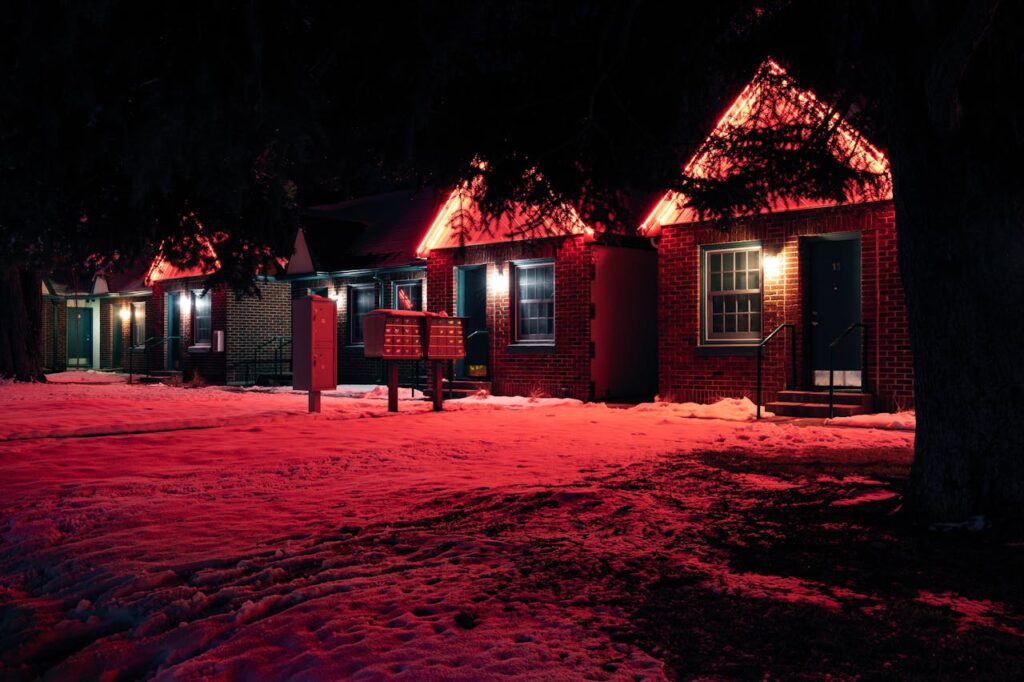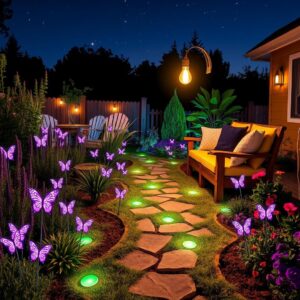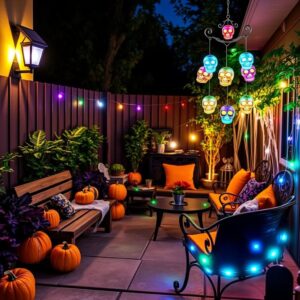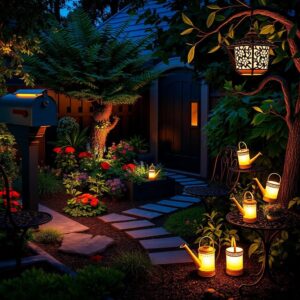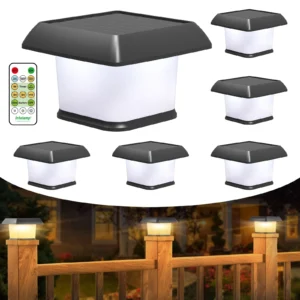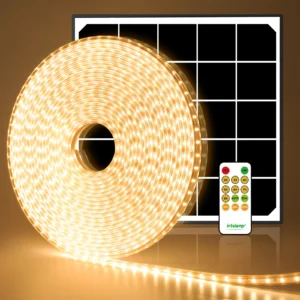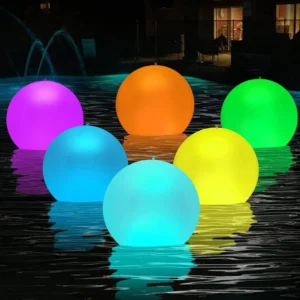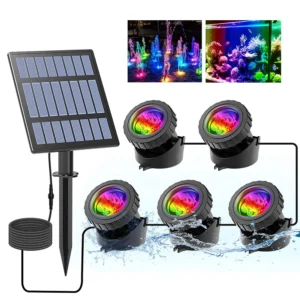As eco-friendly and energy-efficient lighting options, LED solar lights have become increasingly popular. However, many people are concerned about their performance during the winter months, which bring not only colder temperatures but also reduced sunlight. This leads to a common question: Do winter solar lights work effectively in these conditions?
While it’s true that solar lights may only operate for three to four hours during winter evenings, compared to six hours in summer, this does not mean they should be abandoned until spring. Understanding how to use winter solar lights can make all the difference.
Principles for Using Winter Solar Lights
Using solar lights effectively during winter involves understanding their operational dynamics and making necessary adjustments. Here are key principles to keep in mind:
1. Understand Solar Energy Dynamics
Solar lights rely on sunlight for energy, so it’s essential to recognize how winter affects solar energy collection. The sun’s angle is lower during winter months, leading to shorter days and less direct sunlight. This results in decreased energy absorption by solar panels. To combat this, ensure your solar lights are positioned to capture as much sunlight as possible. Choosing larger solar panels or those made from high-efficiency materials, like monocrystalline silicon, can help increase energy conversion rates.
2. Choose the Right Solar Lights
Not all solar lights are designed for winter use. Look for models specifically rated for colder climates, typically with an IP (Ingress Protection) rating of at least IP65. This rating indicates that the lights are protected against dust and low-pressure water jets, making them suitable for rainy or snowy conditions. Higher-rated lights, such as those with IP66 or IP67, offer additional protection against harsher weather, ensuring longevity and consistent performance.
3. Optimize Installation
The placement of solar panels is crucial for their efficiency in winter. Ensure that they are not shaded by trees, buildings, or other structures that could block sunlight. When installing solar lights, adjust their angle to maximize exposure to sunlight throughout the day. It’s also beneficial to periodically reassess the positioning as seasonal changes may alter sunlight availability.
4. Maintain Batteries Effectively
Batteries in solar lights can be affected by colder temperatures, which can reduce their efficiency. To enhance battery performance in winter, consider burying them at a depth that provides insulation against the cold. Using insulation materials around the battery can also help maintain optimal operating temperatures. Regularly check battery health, as older batteries may not hold a charge as well, leading to shorter illumination periods.
5. Regular Maintenance and Cleaning
Maintenance is essential for keeping solar lights functional in winter. Snow and ice can accumulate on solar panels, blocking sunlight and reducing energy collection. Regularly clearing snow and debris ensures optimal performance. Consider tilting solar panels during installation to allow snow to slide off more easily. Additionally, cleaning the panels of dust and dirt will improve their ability to absorb sunlight.
6. Monitor Performance and Adjust
Keep an eye on how well your solar lights are functioning throughout the winter months. If you notice a significant decrease in performance, it may be time to assess the components—such as checking for obstructions, battery health, or overall cleanliness. Regular monitoring allows you to make timely adjustments, ensuring your solar lights remain effective.
By following these principles, you can maximize the efficiency and effectiveness of your winter solar lights, allowing you to enjoy their benefits even in the colder months.
Choosing Solar Lights
Selecting the right solar lights for winter use is crucial to ensure they perform effectively during colder months. Here are essential considerations when choosing winter solar lights:
1. Ingress Protection (IP) Rating
The IP rating indicates how well a solar light is protected against dust and moisture. For winter conditions, aim for lights with at least an IP65 rating, which means they are dust-tight and can withstand low-pressure water jets. Higher ratings, such as IP66 or IP67, provide additional protection, making these lights more resilient against heavy snow, rain, and freezing temperatures. A higher IP rating ensures the longevity of the lights, reducing the risk of damage due to environmental factors.
2. Solar Panel Efficiency
The efficiency of the solar panel is a critical factor in determining how much energy the light can collect. Look for solar panels made from monocrystalline silicon, which are known for their high efficiency and performance in low-light conditions. While polycrystalline and amorphous silicon panels are available, they may not perform as well in winter’s limited sunlight. A larger solar panel surface area can also enhance energy collection, so consider lights with bigger panels for better performance.
3. Battery Capacity and Type
The battery is a key component that stores the energy collected by the solar panels. In winter, when daylight hours are shorter, the battery’s capacity becomes even more important. Opt for lights that use high-quality lithium-ion batteries, as they typically offer better performance and longevity compared to older lead-acid batteries. Look for specifications indicating the battery’s capacity (measured in amp-hours), as a higher capacity means longer illumination times.
4. Light Output and Lumens
Consider the brightness of the solar lights, which is measured in lumens. For outdoor areas that require more illumination, such as pathways or patios, choose lights with higher lumen outputs. Keep in mind that winter solar lights may have lower brightness compared to summer lights due to reduced energy collection. Therefore, it’s beneficial to select lights with adjustable brightness settings, allowing you to optimize their output based on available sunlight.
5. Durability and Build Quality
Winter conditions can be harsh, so durability is key. Look for solar lights made from high-quality materials that can withstand freezing temperatures, snow, and wind. Stainless steel or high-grade plastic casings are excellent choices, as they resist rust and corrosion. Additionally, check if the lights are designed to handle impact; reinforced designs can prevent damage from falling debris or harsh weather.
6. Design and Features
While functionality is important, consider the aesthetic appeal of the solar lights as well. There are various styles available, from decorative fairy lights to sleek pathway lights. Some models come with added features, such as motion sensors, timers, or smart connectivity. These features can enhance security and convenience, making them valuable additions to your outdoor lighting setup.
7. Warranty and Customer Reviews
Before making a purchase, review the warranty provided by the manufacturer. A longer warranty period typically indicates confidence in the product’s durability and performance. Additionally, reading customer reviews can provide insight into real-world performance, helping you make informed decisions based on the experiences of others.
By carefully considering these factors when choosing winter solar lights, you can ensure that your investment will provide reliable and efficient lighting throughout the colder months. With the right selection, you can enjoy the benefits of solar lighting year-round, regardless of the weather.
Factors Affecting Performance
Understanding the various factors that impact the performance of solar lights during winter is crucial for optimizing their efficiency. Here’s an in-depth look at the key elements that can affect how well your solar lights function in colder months:
1. Seasonal Sunlight Availability
During winter, the duration and intensity of sunlight significantly decrease. The sun’s angle is lower in the sky, resulting in less direct exposure to solar panels. This reduced sunlight leads to lower energy collection, which can affect how long the lights can illuminate at night. To mitigate this, consider using solar lights with larger panels or those designed specifically for low-light conditions, which can capture more energy even when sunlight is limited.
2. Temperature Effects on Batteries
Cold temperatures can severely impact the efficiency of batteries used in solar lights. Typically, battery performance decreases in lower temperatures, causing reduced charge capacity and shorter illumination times. In winter, batteries may struggle to maintain their optimal operating temperature, leading to a phenomenon known as “voltage sag,” where the output voltage drops, resulting in dimmer lights. To enhance battery performance, choose high-quality lithium-ion batteries and consider insulating the battery compartments to protect them from extreme cold.
3. Solar Panel Orientation and Positioning
The positioning and angle of solar panels are critical for maximizing sunlight exposure. In winter, any obstruction—such as buildings, trees, or fences—can shade the solar panels, further limiting energy collection. Regularly assess the installation site to ensure that solar panels are oriented towards the sun and adjust their angle to capture maximum sunlight throughout the day. If trees or buildings block sunlight, consider relocating the solar lights or trimming the obstructions.
4. Accumulation of Snow and Debris
Snow, ice, and debris can accumulate on solar panels, significantly reducing their ability to absorb sunlight. This accumulation blocks the panels and prevents them from generating the necessary energy to power the lights. Regular maintenance is essential: clear snow and debris from the panels as soon as possible to maintain efficiency. Installing solar panels at a slight tilt can help snow slide off more easily, reducing the need for frequent cleaning.
5. Dust and Environmental Factors
In addition to snow, dust and dirt can build up on solar panels, obstructing light absorption. Seasonal changes can lead to increased dust accumulation, particularly in dry or windy areas. It’s important to clean the panels regularly to ensure they remain effective. Use a soft cloth or sponge and mild soap to gently clean the surface without scratching the panel, as this will enhance light absorption.
6. Quality of Components
The quality of the solar light components—such as the solar panel, battery, and LED bulbs—plays a significant role in overall performance. Lower-quality components may result in inefficient energy conversion, faster degradation, and shorter lifespans. When selecting solar lights, invest in reputable brands known for high-quality materials and components. Reading customer reviews can provide insights into the durability and reliability of specific models.
7. Lifespan and Wear of Solar Lights
As with any technology, solar lights have a limited lifespan, typically ranging from 5 to 7 years, depending on usage and environmental conditions. Over time, batteries may lose their ability to hold a charge, and solar panels may become less efficient. Regularly inspect your solar lights for signs of wear and tear. If you notice a significant decrease in performance, it may be time to replace the battery or the entire unit.
8. Local Climate Conditions
The effectiveness of winter solar lights can also be influenced by the specific climate of your location. Areas with heavy snowfall or prolonged periods of overcast skies will naturally see more significant challenges in energy collection. Be aware of the local weather patterns and choose solar lights that are specifically designed to withstand your area’s climate. For regions with harsh winters, investing in more robust and high-performing solar lights will ensure reliability.
Solutions for Optimizing Winter Solar Lights Performance
To ensure your solar lights operate effectively throughout winter, several solutions can address common challenges. Here’s a detailed look at practical strategies to enhance performance during colder months:
1. Select High-Quality Solar Products
Investing in high-quality solar lights designed for winter conditions is crucial. Look for lights with durable materials, high-efficiency solar panels, and reliable batteries. Choosing products from reputable manufacturers can ensure that they are built to withstand extreme temperatures and provide adequate brightness during short winter days. Models with features like adjustable brightness and integrated sensors can further optimize energy use.
2. Optimize Solar Panel Placement
Proper placement and orientation of solar panels can significantly increase energy absorption. Ensure panels are positioned to receive direct sunlight for as long as possible during the day. Consider the following tips:
- Avoid Obstructions: Regularly check for and remove any nearby obstructions, such as overhanging branches or structures, that may cast shadows.
- Angle Adjustment: Adjust the angle of the solar panels to capture maximum sunlight, especially during low-angle winter sun.
3. Enhance Battery Protection
To improve battery performance in cold temperatures, implement the following strategies:
- Insulate the Battery: Use insulating materials to shield the battery from extreme cold. This can involve wrapping it in insulating foam or placing it within a protective enclosure.
- Optimal Burial Depth: If batteries are buried, ensure they are deep enough to avoid freezing, ideally surrounded by a layer of sand for better insulation.
4. Regular Maintenance and Cleaning
Maintaining your solar lights is essential for optimal performance:
- Clear Snow and Debris: Regularly remove snow and ice from solar panels to prevent energy loss. A soft broom or brush can be effective for this task.
- Clean Solar Panels: Periodically clean panels of dust and dirt using a mild soap solution to maintain maximum light absorption. This is particularly important in areas prone to dust accumulation.
5. Monitor and Adjust Settings
Regular monitoring of your solar lights can help you identify any issues early. Make adjustments as necessary:
- Check Light Functionality: Test your solar lights periodically to ensure they are functioning correctly. Look for dimming or flickering as signs of potential battery or panel issues.
- Adjust Brightness Settings: If your solar lights come with adjustable brightness, set them to a lower setting when the nights are particularly long, conserving energy while still providing adequate illumination.
6. Utilize Auxiliary Power Sources
For regions with extremely limited sunlight, consider using auxiliary power sources:
- Hybrid Systems: Some solar lights allow for connection to external power sources, such as batteries or grid power. This can help supplement energy during particularly overcast or snowy days.
- Rechargeable Battery Options: Consider using solar lights that support interchangeable rechargeable batteries, allowing for easy replacement if performance declines.
7. Implement Smart Technology
Leverage smart technology to enhance the efficiency of solar lighting systems:
- Smart Sensors: Utilize models with motion sensors that activate only when needed, conserving energy and extending illumination duration.
- Smart Timers: Setting timers can optimize when lights are turned on or off, ensuring they only operate during peak darkness hours.
8. Seasonal Assessment and Upgrades
At the end of the winter season, evaluate the performance of your solar lights:
- Assess for Damage: Check for any signs of wear and tear caused by winter conditions. Replace any damaged components promptly.
- Consider Upgrades: If your solar lights are consistently underperforming, consider upgrading to newer models with improved technology designed for efficiency in various weather conditions.
Recommended Types of Winter Solar Lights
Choosing the right type of solar lights is essential for ensuring effective performance during the winter months. Various designs cater to different needs and conditions, making them suitable for low sunlight and cold temperatures. Here’s an overview of the best options:
1. Solar Garden Lights
These decorative lights are perfect for illuminating pathways, flower beds, or garden areas. Look for models that feature:
- Bright LED Bulbs: High-lumen LED bulbs provide better illumination, ensuring visibility even during long winter nights.
- Wide Solar Panels: Larger panels can collect more sunlight, increasing energy storage for nighttime use.
- Weather Resistance: Ensure that the lights have a high Ingress Protection (IP) rating, ideally IP65 or above, to withstand rain, snow, and frost.
2. Solar Pathway Lights
Ideal for illuminating walkways and driveways, solar pathway lights should be:
- Durable and Sturdy: Choose robust designs that can withstand harsh weather conditions, such as high winds or heavy snowfall.
- Adjustable Brightness: Some models offer adjustable brightness settings, allowing you to conserve energy while still providing safety and visibility.
- Flexible Installation Options: Look for lights with versatile mounting options, making it easy to position them for optimal sunlight exposure.
3. Solar String Lights
Perfect for adding a festive touch to outdoor spaces during winter, solar string lights are:
- Low Power Consumption: These lights often use tiny LED bulbs that require minimal energy, making them ideal for use when sunlight is scarce.
- Versatile: Use them to decorate trees, fences, or patios, enhancing the aesthetic appeal of your outdoor space.
- Weather-Resistant: Ensure they are designed for outdoor use, with protective casings against moisture and cold temperatures.
4. Solar Flood Lights
For areas needing high-intensity lighting, solar flood lights are an excellent choice:
- High Lumens Output: These lights provide powerful illumination, making them suitable for security purposes or brightening large outdoor areas.
- Motion Sensor Features: Many flood lights come with motion sensors that activate the lights only when movement is detected, conserving energy.
- Adjustable Solar Panels: Some models allow for panel adjustment to maximize sun exposure throughout the day.
5. Solar Lanterns
Portable solar lanterns are versatile and practical for winter use:
- Portability: Easily move these lanterns to different locations as needed, whether for camping or backyard gatherings.
- Multiple Light Modes: Many solar lanterns come with various light settings, including warm glow options that enhance ambiance during winter evenings.
- Built-in USB Charging: Some models feature the ability to charge via USB, providing flexibility during extended periods of low sunlight.
6. Solar Motion Sensor Lights
These lights are designed to enhance security while being energy-efficient:
- Automatic Activation: Motion sensors ensure the lights turn on only when movement is detected, conserving battery power.
- Bright Illumination: Look for models with high-intensity LEDs that provide clear visibility and deter potential intruders.
- Durability: Ensure the lights are rated for outdoor use and can withstand winter conditions, including rain and snow.
7. Solar Wall Lights
Perfect for illuminating entryways, patios, or decks, solar wall lights should feature:
- Compact Design: Space-saving designs are great for tight areas while still providing adequate light coverage.
- High IP Rating: Ensure they are rated for outdoor use to resist the elements and provide longevity.
- Stylish Options: Available in various styles, these lights can enhance the aesthetic of your home while providing practical lighting.
8. Solar Floodlight with Timer
For comprehensive outdoor lighting solutions, consider solar floodlights with timers:
- Energy Management: Timers allow you to set specific times for when lights should operate, maximizing efficiency based on daylight hours.
- Customizable Settings: Many models come with adjustable brightness and motion detection features to suit various lighting needs.
- Wide Coverage: Ideal for larger outdoor areas, these floodlights provide extensive illumination while still being energy-efficient.
Conclusion
Using winter solar lights effectively involves understanding how they operate and taking specific steps to maximize their performance during the colder months. By choosing suitable products, positioning them wisely, maintaining them properly, and understanding the effects of seasonal changes, you can enjoy the benefits of solar lighting year-round.

